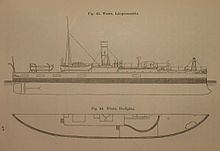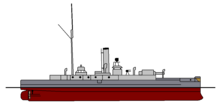
In naval terminology, a destroyer is a fast, maneuverable, long-endurance warship intended to escort larger vessels in a fleet, convoy, or carrier battle group and defend them against a wide range of general threats. They were originally conceived in 1885 by Fernando Villaamil for the Spanish Navy as a defense against torpedo boats, and by the time of the Russo-Japanese War in 1904, these "torpedo boat destroyers" (TBDs) were "large, swift, and powerfully armed torpedo boats designed to destroy other torpedo boats". Although the term "destroyer" had been used interchangeably with "TBD" and "torpedo boat destroyer" by navies since 1892, the term "torpedo boat destroyer" had been generally shortened to simply "destroyer" by nearly all navies by the First World War.

A torpedo boat is a relatively small and fast naval ship designed to carry torpedoes into battle. The first designs were steam-powered craft dedicated to ramming enemy ships with explosive spar torpedoes. Later evolutions launched variants of self-propelled Whitehead torpedoes.

A monitor is a relatively small warship that is neither fast nor strongly armored but carries disproportionately large guns. They were used by some navies from the 1860s, during the First World War and with limited use in the Second World War.

An ironclad was a steam-propelled warship protected by steel or iron armor constructed from 1859 to the early 1890s. The ironclad was developed as a result of the vulnerability of wooden warships to explosive or incendiary shells. The first ironclad battleship, Gloire, was launched by the French Navy in November 1859, narrowly preempting the British Royal Navy. However, Britain built the first completely iron-hulled warships.

A warship or combatant ship is a ship that is built and primarily intended for naval warfare. Usually they belong to the armed forces of a nation. As well as being armed, warships are designed to withstand damage and are typically faster and more maneuverable than merchant ships. Unlike a merchant ship, which carries cargo, a warship typically carries only weapons, ammunition and supplies for its crew. Warships usually belong to a navy, though they have also been operated by individuals, cooperatives and corporations.

A gunboat is a naval watercraft designed for the express purpose of carrying one or more guns to bombard coastal targets, as opposed to those military craft designed for naval warfare, or for ferrying troops or supplies.

SMS Ariadne was the fifth member of the ten-ship Gazelle class of light cruisers that were built for the German Kaiserliche Marine in the late 1890s and early 1900s. The Gazelle class was the culmination of earlier unprotected cruiser and aviso designs, combining the best aspects of both types in what became the progenitor of all future light cruisers of the Imperial fleet. Built to be able to serve with the main German fleet and as a colonial cruiser, she was armed with a battery of ten 10.5 cm (4.1 in) guns and a top speed of 21.5 knots.

In late 19th-century naval terminology, torpedo gunboats were a form of gunboat armed with torpedoes and designed for hunting and destroying smaller torpedo boats. By the end of the 1890s torpedo gunboats were superseded by their more successful contemporaries, the torpedo boat destroyers.

The König class was a group of four dreadnought battleships built for the German Kaiserliche Marine in the early 1910s. The class comprised König, the lead ship, Grosser Kurfürst, Markgraf, and Kronprinz. The design for the ships was derived from the preceding Kaiser class, using the same basic hull but with a rearranged main battery of ten 30.5 cm (12 in) guns in five twin-gun turrets to improve the guns' firing arcs. Instead of the staggered wing turrets used in the Kaisers, the Königs placed their main guns all on the centerline using superfiring pairs fore and aft. Budgetary constraints and the need to begin construction quickly to compete with Britain in the Anglo-German naval arms race prevented any more radical changes. Diesel engines were planned for the ships, but they could not be readied in time, so all four vessels reverted to steam turbines for their propulsion system.

The Brandenburg class consisted of four pre-dreadnought battleships built for the German Kaiserliche Marine, the first modern battleships of the fleet. The four ships of the class—Brandenburg, Wörth, Weissenburg, and Kurfürst Friedrich Wilhelm—were the first ocean-going capital ships built for the German fleet in nearly two decades, owing to reluctance in the Reichstag to fund large projects. They followed a series of small coastal defense ships, and though in retrospect they anticipated the buildup that created the High Seas Fleet, they were ordered as part of a construction program that reflected the strategic and tactical confusion that affected many navies in the 1880s. The design process that resulted in the Brandenburg class was very lengthy, with proposals that ranged from outdated casemate ships to versions with two twin-gun turrets placed side by side. The designers ultimately settled on ships that were armed with an unusual main battery of six 28 cm (11 in) guns at a time when all foreign battleships were built with four or fewer heavy guns.

The Sachsen class of armored corvettes was a class of four ships built by the Imperial German Navy in the late 1870s to early 1880s. The ships—Sachsen, Bayern, Württemberg, and Baden—were designed to operate as part of an integrated coastal defense network. The ships were intended to sortie from fortified bases to break up an enemy blockade or landing attempt. Armed with six 26 cm (10.2 in) guns, they were also intended to fight hostile ironclads on relatively equal terms.
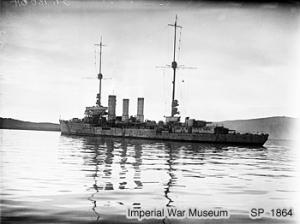
SMS Emden was a German light cruiser belonging to the Königsberg class, built during the First World War. Emden served in the German Kaiserliche Marine until the end of the war, at which point she was ceded to France. The ship was named after the previous Emden, which had been destroyed at the Battle of Cocos earlier in the war. She mounted an Iron Cross on her stem-head in honor of the earlier Emden. The new cruiser was laid down in 1914 at the AG Weser shipyard in Bremen, launched in February 1916, and commissioned into the High Seas Fleet in December 1916. Armed with eight 15 cm SK L/45 guns, the ship had a top speed of 27.5 kn.
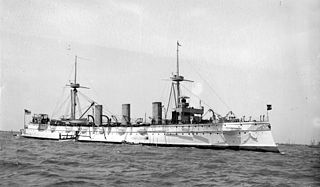
SMS Kaiserin Augusta was a unique protected cruiser, built for the German Kaiserliche Marine in the early 1890s. Named for Empress Augusta, who died in January 1890, she was laid down in 1890, launched in January 1892, and completed in November of that year. Owing to budgetary restrictions, Kaiserin Augusta was designed to fill both fleet scout and colonial cruiser roles. The ship was initially armed with a main battery of four 15 cm (5.9 in) and eight 10.5 cm (4.1 in) guns, which by 1896 was replaced with twelve new model 15 cm guns. She was the first ship in the German Navy to feature a three-shaft propeller arrangement.

The Alarm-class torpedo gunboat was the penultimate class of torpedo gunboat built for the Royal Navy. The class was contemporary with the early torpedo boat destroyers, which were faster and thus better suited to pursuit of enemy torpedo boats. By World War I the class had either been sold, converted to submarine depot ships or minesweepers, or reduced to harbour service. Three of the class were lost during World War I while serving in the minesweeping role.

The Rhein class of ironclad riverine monitors (Flußkanonenboote) were a pair of ships built by the German Imperial Navy in the aftermath of the Franco-Prussian War. The class comprised two ships, Rhein and Mosel; both were built by the AG Weser shipyard in Bremen, in 1872–1874. They were armed with a pair of 12 cm (4.7 in) bronze cannon in a revolving gun turret. The ships were intended to protect the German border with France in the event of a conflict, but had short service lives, as war did not come. They served briefly in the defenses of Coblenz, starting in 1875, before being withdrawn from service. The two ships were sold for scrap, apparently in December 1884.

Flat-iron gunboats were a number of classes of coastal gunboats generally characterised by small size, low freeboard, the absence of masts, and the mounting of a single non-traversing large gun, aimed by pointing the vessel. They acquired their nickname from the physical similarity with the flat iron used for ironing clothes during the 19th century.

A torpedo cruiser is a type of warship that is armed primarily with torpedoes. The major navies began building torpedo cruisers shortly after the invention of the locomotive Whitehead torpedo in the 1860s. The development of the torpedo gave rise to the Jeune École doctrine, which held that small warships armed with torpedoes could effectively and cheaply defeat much larger battleships. Torpedo cruisers fell out of favor in most of the great power navies in the 1890s, though many other navies continued to acquire them into the early 1900s.

The Zara class was a class of three torpedo cruisers built for the Austro-Hungarian Navy in the late 1870s and early 1880s; they were the first large torpedo-armed warships built by Austria-Hungary. The class comprised three ships, Zara, Spalato, and Sebenico; the last vessel was built to a slightly different design, and is sometimes not counted as a member of the class. The design was prepared by Josef von Romako, the Chief Constructor of the Austro-Hungarian Navy, after a lengthy design process throughout the 1870s. The first two ships were armed with deck-mounted torpedo tubes, while Sebenico received an experimental tube in her bow, submerged below the waterline.
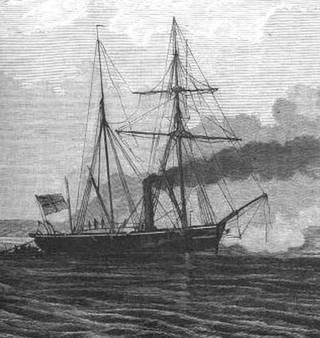
SMS Comet was a Camäleon-class gunboat of the Prussian Navy that was launched in 1860. A small vessel, armed with only three light guns, Comet served during the Second Schleswig War of 1864 and the Franco-Prussian War of 1870–1871, part of the conflicts that unified Germany. The ship was present at, but was only lightly engaged in the Battle of Jasmund during the Second Schleswig War. She served in a variety of roles during peacetime, including fishery protection and survey work. Comet went on one lengthy deployment abroad, with an assignment to the Mediterranean Sea from 1876 to 1879. She saw little active service after returning to Germany and was decommissioned and hulked in 1881. The vessel remained in the navy's inventory until at least 1891, being broken up sometime thereafter.


